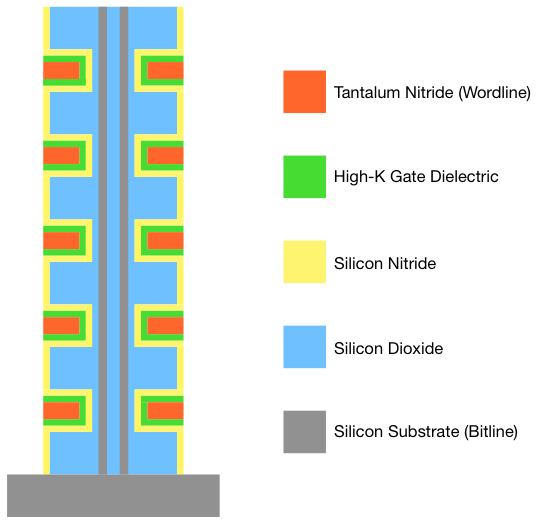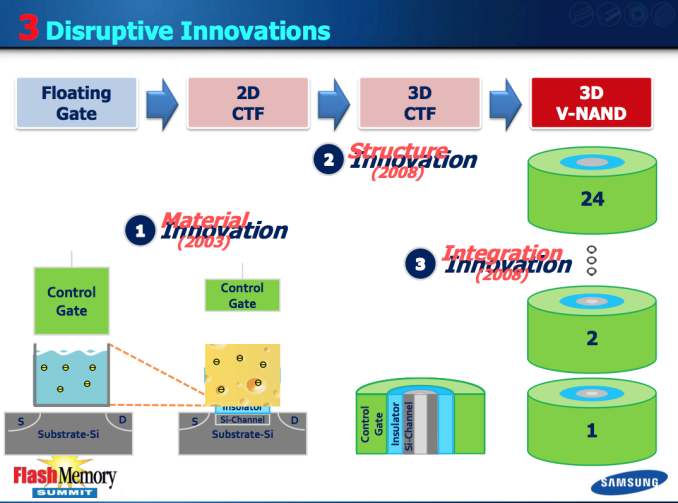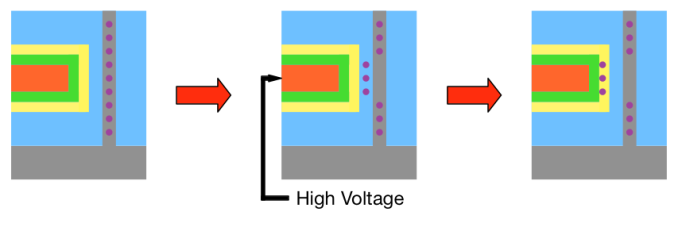Samsung SSD 850 Pro (128GB, 256GB & 1TB) Review: Enter the 3D Era
by Kristian Vättö on July 1, 2014 10:00 AM EST3D NAND: How It Works
To understand how 3D NAND helps to keep Moore's Law in action, we first need to go in-depth with the structure. Before we begin, there are a couple of disclaimers I want to get out. First of all, every manufacturer has a different 3D NAND structure, so to avoid information overflow and confusion, I will only talk about Samsung's structure for now. When other manufacturers are ready with their 3D NAND products, I will provide a similar analysis of their structure. Secondly, there is not much detailed information about Samsung's 3D NAND, or V-NAND as they call it, so I am mostly basing my analysis on The Memory Guy's blog post (also known as Jim Handy, a respected semiconductor analyst).
What you are seeing above is a 5-layer 3D NAND string based on Samsung's TCAT (Terabit Cell Array Transistor) structure. It consists of a total of ten cells and similar to 2D NAND each cell is capable of holding one, two or three bits of data depending on whether the NAND is SLC, MLC or TLC. Samsung's current (i.e. second) generation V-NAND has 32 layers, meaning that it is simply a taller tower but to keep the graph easily readable I decreased the number of layers to five.
There is one fundamental difference between Samsung's V-NAND. With 2D NAND, the charge was stored in a conductive floating gate but as you can see in the graph above, there is not one in Samsung's V-NAND. Instead Samsung uses a design called Charge Trap Flash (CTF), which means that the charge is stored in an insulator, which is silicon nitride in this case.
Some of you might remember this rather hilarious slide we used in our V-NAND announcement article and I now have an explanation as to why Samsung used cheese in in (yes, it indeed is cheese). A traditional floating gate works pretty much like a bucket of water. As long as there is not a hole in the bucket, the water stays there without an issue. However, if you get even a tiny hole in the bucket, all the water will sooner than later escape through that hole. It is the same with a floating gate because if there is a hole in the insulating material around it (Inter Poly Dielectric and tunnel oxide), all the electrons in the floating gate will escape through that as the floating gate is conductive and the electrons can move freely. As I mentioned on the previous page, this is exactly what happens when NAND is cycled and wears out because the stress caused by the programming operation causes the insulators to lose their insulating characteristics.
With Charge Trap Flash that does not happen because the electrons reside in an insulator. Samsung compared the bucket of water idea to cheese, meaning that if there is a hole the cheese will not just pour out from it like water would.
As a result, Charge Trap Flash increases endurance as it is not as vulnerable to wear out. I am also told that CTF does not require as high programming voltages as floating gates do (up to 20V), which reduces the stess on the insulators. I wonder if this is simply because the insulators do not have to be that thick anymore (a miminum of 7nm for tunnel oxide and 12nm for ONO) because the charge trap is not as dependent on the surrounding insulators as floating gate is. The reason why such a high voltage is needed for 2D NAND programming is the thickness of the tunnel oxide because otherwise the electrons cannot tunnel through (remember, the electrons are shot through an insulator). On the other hand, the tunnel oxide cannot be made any thinner than 7nm or otherwise data retention takes a massive hit (NAND is really an engineers dream, isn't it? Touch one thing and you break another).
Another interesting tidbit regarding Samsung’s V-NAND is the usage of a high-K dielectrics. IMFT did a similar switch when they moved to 20nm node but all the other manufacturers, as far as I know, have stayed with an inter poly dielectric (IPD) design. I went into detail about high-K dielectrics in our Crucial MX100 review but I will provide a quick summary here. Basically, a high-K dielectric is a material with a high dielectric constant, which is quite surprisingly known as K. The benefit of a high-K dielectric over a normal dielectric (like oxide-nitride-oxide i.e. ONO in NAND) is that it provides a higher capacitance between the word and bitlines. Similar to 2D NAND, the capacitance between the control gate and the floating gate, or charge trap in the case of V-NAND, is still the key factor for operation. The usage of high-K dielectrics gives Samsung a bit more headroom in terms of vertical scaling as layers can be stacked closer to each other and it also improves endurance as high-K dielectrics have less leakage compared to normal dielectrics.
Otherwise the basics of V-NAND are very similar to 2D NAND. To program a cell, the bitline is grounded (i.e. held at 0V) while a high voltage is placed on the wordline. That makes the electrons that are floating in the bitline to tunnel through the silicon dioxide to the charge trap a.k.a. silicon nitride.
I made a very simple graph of V-NAND programming, which should help you to understand the process. The elements are the same as in the tower graph with the difference that it is just one layer and I cut the tower in half to fit it on the page. The purple balls are electrons.
Reading from V-NAND works exactly the same as with 2D NAND. The wordline of the cell-to-be-read is held at 0V while different voltages are applied on the bitline. Once the correct voltage is found, the cell will conduct and the sense amp will read the data depending on what the voltage was (the voltage determines the voltage state, i.e. what the value is).













160 Comments
View All Comments
Cerb - Tuesday, July 1, 2014 - link
As soon as it is cheap enough. But, don't get your hopes up about performance. SD cards are mostly limited by the controllers being slow, and in the tiny package they fit in, with the narrow margins they have, there's not a lot of room, physically and economically, to give them fast controllers, even if you get a big one that must have several NAND dies, and are talking about full-size SD, where multiple channels might be viable. It sucks, and I dislike shopping for SD cards as much as anybody, but today, that's how it is.frenchy_2001 - Tuesday, July 1, 2014 - link
I think he was talking about V-NAND (3D cells) which is independent of the controller.I would guess it will, as density will continue to scale up which will make it the cheaper technology.
It is cutting edge now, but will let Samsung scale higher densities very aggressively in the coming years, replacing all their 2D NAND production (they announced it when presenting the 3D cells).
Harry Lloyd - Tuesday, July 1, 2014 - link
Personally I have no interest in this kind of performance, and I really hope they focus on reducing prices and increasing capacities. The MX100 is just great for home usage (system and gaming), and I would like to see a 512 GB equivalent for around 100 $ by the end of 2015.Spatty - Tuesday, July 1, 2014 - link
"Oftentimes when cell size is discussed, it is only the actual size of the cell that is taken into account, which leaves the distance between cells out of the conclusion."Incorrect. Oftentimes what is being discussed is the half pitch. The 16nm, 19nm, 20nm, etc of the die. That is not the cell. The cell is Always defined as the repeatable structure in a memory device, and this includes the space between cells as described. The cell size is incorrectly referenced as being the half pitch.
Then there is marketing gimmick by companies who call their products 19nm when it is really 19nm by 2xnm. A rectangle and not a true 19nm square half pitch.
Larry Endomorph - Tuesday, July 1, 2014 - link
Good review. Bad charts. All of these are useless to color blind people:http://images.anandtech.com/doci/8216/NAND%20overv...
http://images.anandtech.com/doci/8216/cell%20inter...
http://images.anandtech.com/doci/8216/V-NAND_1.png
http://images.anandtech.com/doci/8216/850%20Pro%20...
http://images.anandtech.com/doci/8216/850%20Pro%20...
http://images.anandtech.com/doci/8216/850%20Pro%20...
http://images.anandtech.com/doci/8216/850%20Pro%20...
http://images.anandtech.com/doci/8216/850%20Pro%20...
http://images.anandtech.com/doci/8216/850%20Pro%20...
http://images.anandtech.com/doci/8216/850%20Pro%20...
http://images.anandtech.com/doci/8216/850%20Pro%20...
Cerb - Tuesday, July 1, 2014 - link
I never paid much attention, but you're right. If they changed the point shapes, and maybe dashed a couple of the lines, they could take care of that easily.fokka - Tuesday, July 1, 2014 - link
it's great to see a new drive from samsung and even greater seeing them advancing ssd tech and performance in such substantial ways. keeping that in mind i'm not really surprised about the msrp sammy is asking for its drives. and as always when new devices hit the scene, we're comparing msrp with real market prices here, so the difference should be a bit lower in a couple weeks when enough stock is available.that said, even if sata3 remains the most important storage interface today, it's kind of a shame seeing such a beautiful drive limited by this "old" interface. i know the new standards like m2, sata3.2 and pci-e-drives are still kind of a mess, but we already saw what higher throughputs in combination with more efficient interface protocols can do and seeing an expensive enthusiast drive like the 850 pro connected to sata3 just makes it seem more limited than it needed to be.
all that said, it doesn't change much for the average user, or advanced users even, since for most people a good sized evo or crucial is all they ever need in the years to come. upgrading to expensive drives like the 850 will only make sense for the most demanding users, for the rest it will only get interesting again when pci based storage gets more affordable.
Daniel Egger - Tuesday, July 1, 2014 - link
Minor nit: There's no such thing as "pentalobe torx" it's either one or the other but I'm guessing that it might have been torx security since pentalobe screws have only been used by Apple a couple of years back.iwod - Tuesday, July 1, 2014 - link
Its great to see its doing well in power consumption area. Which is important in Notebook. I hope we could bring this down to 2W or even 1.5W during operation.I really do think our SSD storage tier deserve a PCI-E lane direct from CPU. It would be great if the market just settle on 2x PCI-E 3.0 from CPU. We get 2GB/s out of it. That is plenty of headroom to grow until we move to PCI-E 4.0
hojnikb - Tuesday, July 1, 2014 - link
Thats what sata-express is doing